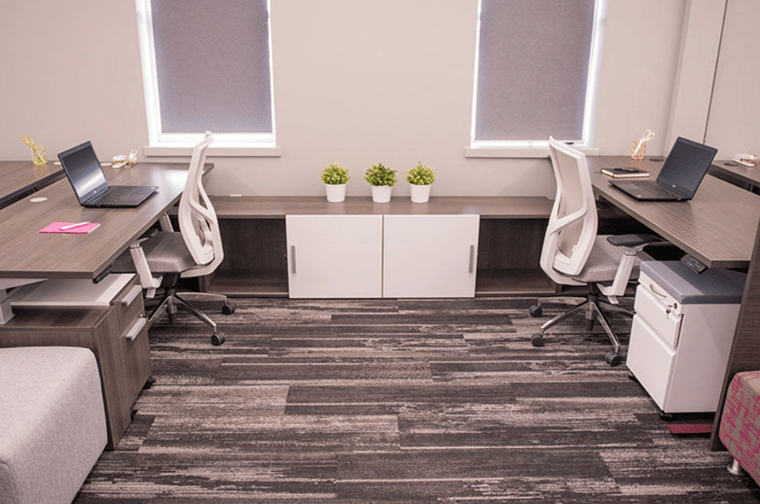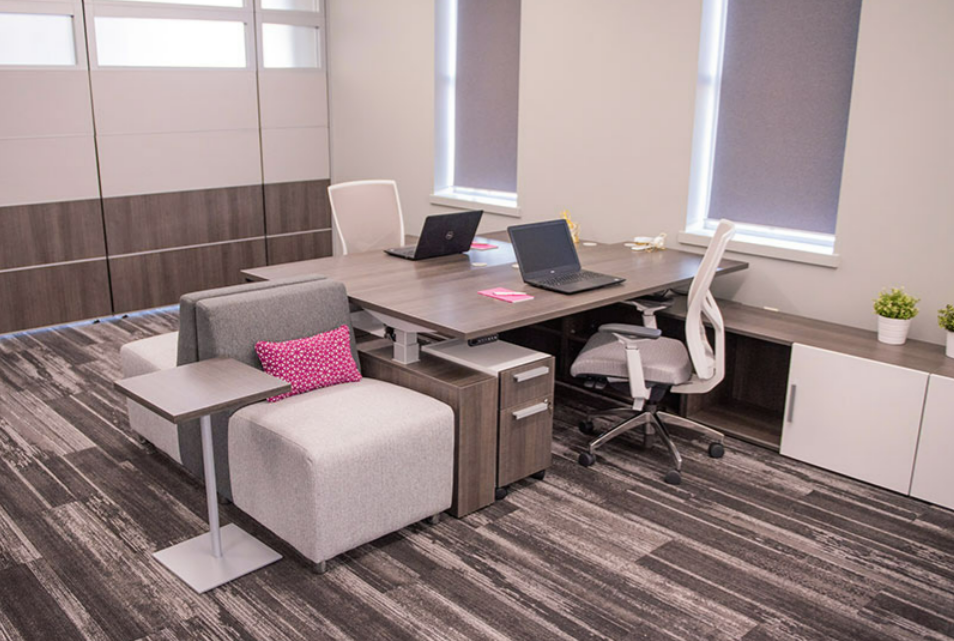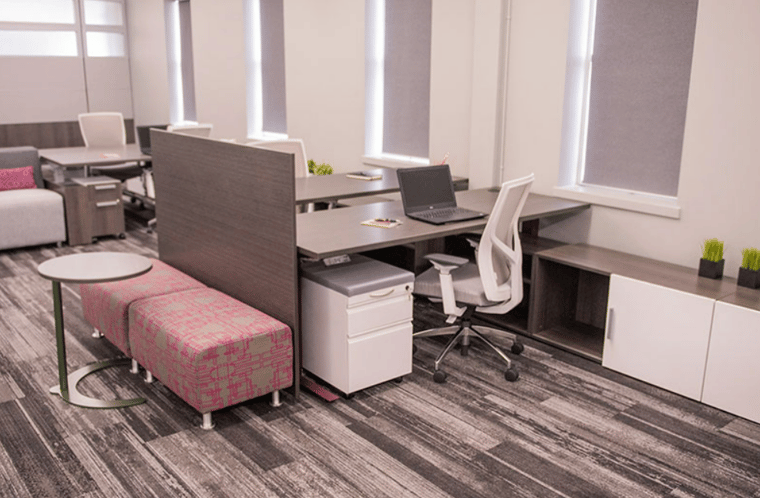Office Space Design That Your Employees Will Love — No Matter the Size of Your Space
Office space design is more than just setting up cubicles in a large room for people to work. Through intentional design of your business interior, you can create increased employee engagement, job satisfaction, and even retention.
A well-designed office can impact your team’s efficiency, productivity, morale, and general attitude. And the same space speaks volumes to your clients and customers.
So, how do you design an office that your employees will love? Does this mean a full-on renovation? Do you have the space? Where do you start? There are several questions that crop up when you start thinking about office space design. In this blog, we’ll walk you through some of the initial planning and prep to get you started, as well as provide 10 practical tips for creating an inspiring office that your employees will love.
Preparation and Planning are Key to Office Space Design
In order to ensure you get the most value for your time and money, invest in preparation and planning before designing anything. First, you want to consider timing. If you’re planning on a redesign or renovation, give your team plenty of time to execute. Typically, furniture lead times are 6-8 weeks but are sometimes pushed because of supply issues.
It’s also really important to determine what works best for your business and what isn’t currently working to get a better idea of where you might focus your efforts before jumping into the design process. Here are 7 key tips to understanding your team and other important factors to consider when kicking off your office space design:
- Observe your team’s dynamic. When you know your team, you can create a space that suits their unique needs. Figure out how your team uses their current space, are there any obstacles in collaboration, and what are some regular complaints about the space that could be alleviated? All of this will inform design.
- Design with company culture in mind. No two companies' cultures are exactly alike, and the right office space design will not only recognize the difference but celebrate them. Make sure your space showcases the defining characteristics that give your business interior personality and help attract and retain clients, vendors, partners, and talent.
- One size does not fit all. Taking a one-size-fits-all approach to office design doesn’t typically work. As we’ve already established, businesses, their teams, and their cultures are different. Your team may need a workspace to collaborate and ask questions of each other, while another team may need quiet, individual desk space to do their work. Identify the variables that affect your team the most and design for those.
- Reimagine space allocation. If there is an opportunity to rethink space allocation, now is the time. Upper management and senior staff have historically gotten office space that may go unused, depending on the demands of their job. Think about how you can better allocate that space to improve your office’s atmosphere.
- Embrace technology. The right office space design, and the furniture and accessories you gravitate toward, will depend in large part on the technology that your team uses on a regular basis. We work in an increasingly connected world and now is the perfect opportunity to create a modern, tech-friendly workplace that maximizes productivity.
- Balance collaboration and privacy. Striking a balance between collaboration and privacy allows employees to have the best of two worlds. Providing a variety of spaces for different work styles ensures that employees work better together while also finding space to concentrate when needed.
- Base your office design on activities. In line with balancing collaboration and privacy, it may help to design your office space with your team’s day-to-day activities in mind. Private areas to take calls, quiet zones for focused work, and social hubs for breaks and reenergizing conversation. By considering all of the activity that happens in your office, you can design spaces that accommodate them.

10 Tips for an Inspiring Office Space Design
Office space design is all about creating spaces that are not only multi-purpose but take advantage of healthy design trends — which can motivate and inspire your team to do their best work. Here are ten different, practical ways to incorporate modern design into your office to boost employee morale, productivity, and engagement:
- Offer a variety of seat and desk options. A big trend in office design is “space variety.” This means there is a heavy focus on the balance between collaboration and privacy in the form of individual workstations, tables, functional meeting spaces, quiet areas, and even soft seating. This allows anyone to work however they do it best.
- Hide the wire clutter. Nothing slows down productivity and clogs inspiration like a tangle of electrical cords. Wireless may be ideal, but unrealistic. So finding a wire management system that works for your business is essential because getting organized can clear up the employee’s workspace and their headspace.
- Choose natural light. Increasing natural light not only opens a space up but creates a bright and welcoming atmosphere, which is crucial to motivation and inspiration. Incorporating natural light in your office space design could mean making sure employee workstations are positioned near windows, opening the blinds, or even adding skylights. When extra windows aren’t possible, just improving the quality and amount of artificial lighting can make a huge difference.
- Take down the walls. Open-concept office designs have been shown to promote collaboration and engagement. Moreso, without floor-to-ceiling walls and high partitions, your office design can be flexible and highly customized to the activities that happen in each area. Wide open spaces can help to boost creativity and performance, so steer clear of walls and closed-off workspaces.
- Bring the outside in. Incorporating natural accents like plants, wood, stone, and even water features is all part of biophilic design. It’s a nod to making the workplace feel more like a living space by connecting people to nature. This can be done whether you have an actual outdoor space or want to liven up your indoor space. The intent is to create an office that is comfortable and inviting.
- Inspire your team with color. Color can play a huge role in the motivation and inspiration of your employees. No one wants to work in a beige box. Whether you incorporate color through paint, furniture, fabrics, artwork, or decor — the colors you choose can impact the moods and attitudes of your team. You can organize different areas according to a color scheme or simply scatter pops of color around the office — a variety of hues will boost productivity, creativity, and overall happiness.
- Set up multipurpose workspaces. No one space should serve a single purpose. Be intentional with how you set up workspaces and how they can be utilized by your team to maximize not only productivity but efficiency. From quick team meetings to deep research that needs room to spread out, having the space to accommodate all kinds of work ensures that all kinds of work will get done.
- Use a variety of materials and textures. Just like color and biophilic design, a variety of materials and textures can have a direct impact on your team’s productivity and creativity. No one wants to stare at bland plastic all day. Incorporate rough wood, soft fabrics, textured plaster — anything with visual and physical interest — throughout the workspace to continually stimulate your team’s senses and boost their creativity.
- Invest in flexible furniture. Flexibility and adaptability are key to your business’ interior, and this is especially critical for the furniture in your workspace. Flexible furniture, including desks, chairs, workstations, and tables that are easy to move, roll away, fold up, or break down entirely helps to accommodate different working styles and preferences and allows employees to change their scenery during the workday.
- Foster community through design. Designated workspace is important, collaborative tables and seating are helpful, and technology creates seamless productivity; however, a designated space for lounging, conversation, and comfort is crucial to fostering a sense of community and improving overall culture. Soft, lounge seating creates space for your team to momentarily unwind during the day which can provide that extra boost to power through projects.
The Ideal Office Space, and How to Design It
Your ideal office space design will be specific to your business and team, the needs of your employees, and the work that needs to be done. With that in mind, whether you make small or large changes, you can create an office that your employees will be excited to work in.
Here at Kentwood Office Furniture, we have designed hundreds of offices that teams have loved. Several of our projects incorporate all 10 tips on this list, plus countless other factors that our expert designers see fit in the space.
If you’re looking to design a space that will increase your team’s productivity and boost creativity, consider working with us! Our designers, workplace strategist, and furniture experts have been delivering successful workspaces to our clients for over 45 years, with high customer satisfaction. Reach out today to learn more about our design services and how to get started!


